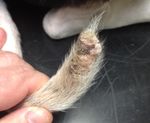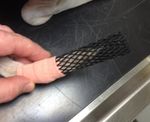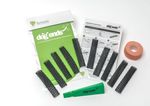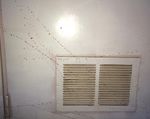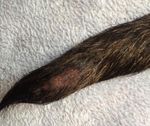Dog Ends - a new treatment for tail tip injuries Clinical presentation
←
→
Page content transcription
If your browser does not render page correctly, please read the page content below
Ivan Crotaz BVetMed MRCVS – Bonovate Veterinary Surgeon
Dog Ends – a new treatment for tail tip injuries
Tail tip injuries in dogs appear to be fairly simple injuries. However, they have the potential to
develop various complications making successful treatment very difficult. This article describes
the use of a new mesh-based dressing developed for the treatment of this injury and also
suggests a management approach that allows various wound complications to be successfully
controlled.
Introduction Clinical presentation
Tail tip injuries in veterinary practice are Tail tip injuries in dogs start as a small
relatively uncommon, with a reported excoriation, typically to the distal tail tip,
incidence of 0.23% (Diesel et.al. 2010), although they can exist further down the tail.
although comments on owners websites Wagging of the tail against any hard surface
suggest that many injuries are treated exacerbates the wound. Most tail injuries in
without veterinary involvement. Spaniels dogs are impact related – without impact
and sighthounds such as Greyhounds, absorption, successful healing is unlikely.
whippets and lurchers are at higher risk of
tail tip injuries.
Without careful management, tail tip injuries
are unlikely to heal and rapidly turn into
chronic haemorrhaging wounds, causing
pain and suffering for the dog and great
difficulties for owners or dog handlers.
Blood is sprayed up the walls when the tail
is wagged and the wound will literally not
heal.
Figure 2 - early tail injury
Various complications including pain, self-
trauma and infection are commonly found.
Tail tip injuries should be treated
immediately when they are minor skin
injuries (Figure 2). Without appropriate
treatment, these wounds will rapidly
deteriorate (Figure 3). A number of
Figure 1 - blood spray from a tail injury
complications are likely to develop. These
reduce the chances of successful treatment.skin infection is common and culture and
sensitivity testing may be useful.
Self trauma from chewing/licking or wagging
will plays a large part in the deterioration of
the wound. It is necessary to prevent the
dog chewing the tail or the dressing,
normally by using an Elizabethan collar.
The largest issue with these wounds is the
continual repeated impacts on the wound
area from tail wagging. Without absorbing
Figure 3 - Chronic tail tip injury these impacts the wound will not heal.
Dog Ends are mesh tubular dressings that Dog Ends applied at this stage are very
are attached to overhang the tail tip. The likely to solve the problem rapidly.
mesh has been engineered to allow the
dressing to flex just sufficiently to absorb The Dog End dressing should be used until
impacts without transmitting the force down the wound has completely healed – this is
to the injured area. Their mesh construction normally until the hair has regrown and
allows superb ventilation to the injured area completely covered the wound area. Hair
with aids in the reduction of infection risk. provides valuable cushioning and for this
reason, the tail tip should not be clipped
unless it is essential to do so to control
infection.
Dog Ends should be applied as shown in
the pack instructions – using anchor tape
placed proximal to the tail wound to prevent
any further skin trauma. (Fig 5,6,7) In some
cases, it can be useful to place a sterile
primary dressing on the wound first to
protect the skin surface. Hydrogel
dressings can also be used beneath the
Figure 4 - Dog Ends treatment pack + instructions primary dressing to encourage tissue repair.
The mesh of the Dog End helps to keep any
primary dressings in place and the
Management of an overhanging tip acts to absorb impact and
remove or reduce the trauma. When
early tail tip injury changing the dressing, it is often possible to
leave the anchor tape in place if it is not
Even at this stage, these injuries will bleed dirty or peeling. Changing the Dog End
profusely. Deep tissue damage or deep takes a few seconds and should be done
skin infection is unlikely at this point, daily or whenever the Dog End is dirty or
although fractures are possible. Superficial damaged.It should take around two weeks for
complete resolution of a tail tip injury, but
longer treatment courses are necessary.
Dog Ends are often used for prevention of
future injuries, for instance with working
dogs or during short periods of kennelling.
Management of a
chronic tail tip injury
Figure 5 – anchor tape in position
Chronic injuries need to be treated rather
differently. Multiple complications are
normally present:
Deep tissue infections – bacteriology
and sensitivity tests are very
important. Multiple antibiotic
resistance may be present if
antibiotics have been used
ineffectually.
Deep soft tissue damage is likely.
Osteomyelitis may also be present.
Radiographs can be used to help to
identify osteomyelitis. An
Figure 6 – primary dressing loosely taped in place
appropriate antibiotic should be used
if infection is identified.
Dogs will be used to chewing or
traumatising these wounds. This is
accentuated by the inevitable pain
associated with chronic wounds.
Pain relief is essential, coupled with
physical wound protection using an
Elizabethan collar. Non-steroidal
anti-inflammatory drugs (NSAIDs)
are normally the most appropriate
analgesic agents for this type of
wound.
Impact trauma is always going to be
Figure 7 – Dog End dressing providing impact present. As before, Dog Ends will
absorption in overhanging area absorb these impacts, eliminating
this from the equation. It may benecessary to use antibiotics, severe scarring, with swollen granulation
NSAIDs and an Elizabethan collar tissue and minimal areas of haired skin.
first for a few days before placing
any dressing on the tail. If tail The difficult nature of the condition was
dressings are used immediately, this explained to the owners, with the need for
can cause extra pain. protracted treatment and potential
In some cases, if the distal tissue is amputation discussed. A Hound Surround
too badly affected, tail tip amputation collar (Bonovate, UK) was used to prevent
can be beneficial, to eliminate the further self-trauma (this collar is smaller
chronically diseased tissue. than a conventional Elizabethan collar, with
Margins must include all infected or superior peripheral vision and ventilation)
traumatised tissue to be effective,
making pre-operative radiography
extremely useful. Dog Ends are
very useful after amputation to
protect the delicate surgical wound.
In this situation it is essential to use
a sterile primary dressing first to
cover the wound, with a Dog End
placed over the top.
Case study:
Figure 9 - Dog End in place on injured tail after 5 days of
analgesic and antibiotic treatment
In this case study, the first image shows a
chronic tail wound on a 7 year old ex-rescue
Figure 8 - Chronic tissue damage
Figure 10 - Tail after 2 weeks of treatment. Soft tissue
swelling eliminated and hair is starting to regrow
Staffordshire Bull Terrier with a two year
history of intermittent tail tip haemorrhage Swabs were taken and submitted for
and self trauma. The tail tip exhibited bacteriological culture and sensitivity testing
and the dog was started on oral cephalexinand meloxicam. Dog Ends were used to eliminate impact injuries. Haemorrhage stopped by the following day as the superficial trauma was removed from the equation. After 2 weeks, superficial inflammatory changes were largely eliminated in the injured area. Soft tissue swelling was eliminated and the tail tip could be handled without pain. Hair re-growth was starting but continued wound protection with the Dog ends and collar was still essential. Amputation might have been considered in this case. However, without very careful protection and pain management, the dog would merely have traumatised the surgical wound, starting the process again. Conclusion Tail tip injuries have a complex aetiology. Elimination of any complicating factors, (especially self –trauma) is essential. Dog Ends eliminate the major factor of impact trauma and aid healing. References Diesel G, Pfeiffer D, Crispin S, Brodbelt D. Risk factors for tail injuries in dogs in Great Britain Veterinary Record 2010;166:812-817
You can also read





